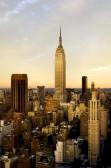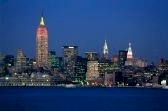 HOBOKEN The country’s first brewery was established in Hoboken, a community first settled by the Dutch in 1642.
In 1784, Colonel John Stevens, a revolutionary war officer and a famous inventor, purchased an estate known as Hobuck Island,
and later auctioned off lots in what he called the New City of Hoboken.
Stevens had been called the Father of American Railroading and he and his sons can take credit for many of the “firsts” here.
He inaugurated the first regular steam ferry service in 1811.
His son John founded the first yacht club in 1844 and originated the first Americas Cup race.
His brother Edwin was responsible for founding Stevens Institute of Technology, one of the first colleges to offer a degree in mechanical engineering
and one of the first that required freshmen to have a personal computer.
The first international cricket match took place in Hoboken in 1859 at The Elysian Fields.
What remains of The Elysian Fields can still be seen at 11th and Washington Streets, where a commemorative plaque can be found.
HOBOKEN The country’s first brewery was established in Hoboken, a community first settled by the Dutch in 1642.
In 1784, Colonel John Stevens, a revolutionary war officer and a famous inventor, purchased an estate known as Hobuck Island,
and later auctioned off lots in what he called the New City of Hoboken.
Stevens had been called the Father of American Railroading and he and his sons can take credit for many of the “firsts” here.
He inaugurated the first regular steam ferry service in 1811.
His son John founded the first yacht club in 1844 and originated the first Americas Cup race.
His brother Edwin was responsible for founding Stevens Institute of Technology, one of the first colleges to offer a degree in mechanical engineering
and one of the first that required freshmen to have a personal computer.
The first international cricket match took place in Hoboken in 1859 at The Elysian Fields.
What remains of The Elysian Fields can still be seen at 11th and Washington Streets, where a commemorative plaque can be found.
In the early years of the 19th century, Hoboken was a popular resort area.
Ferries from NY brought visitors to enjoy the river walks, beer gardens and boarding houses.
By the mid 19th century, Hoboken was an active manufacturing center.
At the beginning of the 20th century, Hoboken was an important shipping center and during WWI was a major port of embarkation for American troops.
Hoboken was a wealthy suburb in the late 1920's.
 Although the charms of Hoboken have been discovered by NY commuters, many old-timers worry about overgentrification.
There are no tall buildings but mostly rows of brownstones, mid 19th century churches, late 19th century firehouses, and early 20th century buildings.
There are also a large number of restaurants for the size of the town.
In 1950, ON THE WATERFRONT was filmed in Hoboken and is also the birthplace of Frank Sinatra.
A turnabout dramatic enough to be called a renaissance began in the late 1960s when the Model Cities Program initiated the rehabilitation of many tenements
as well as the conversion of the Keuffel and Esser Factory into housing.
At the same time, Hoboken began to draw new residents, many of them artists and professionals attracted by Hoboken’s proximity to NY and its small-town “livability”.
Today, the renaissance continues and Hoboken is now at the geographical center of revitalization of the Hudson River’s West Bank.
Change has brought the City new priorities, including affordable housing, the development of the waterfront and the expansion of the commercial and industrial base.
Although the charms of Hoboken have been discovered by NY commuters, many old-timers worry about overgentrification.
There are no tall buildings but mostly rows of brownstones, mid 19th century churches, late 19th century firehouses, and early 20th century buildings.
There are also a large number of restaurants for the size of the town.
In 1950, ON THE WATERFRONT was filmed in Hoboken and is also the birthplace of Frank Sinatra.
A turnabout dramatic enough to be called a renaissance began in the late 1960s when the Model Cities Program initiated the rehabilitation of many tenements
as well as the conversion of the Keuffel and Esser Factory into housing.
At the same time, Hoboken began to draw new residents, many of them artists and professionals attracted by Hoboken’s proximity to NY and its small-town “livability”.
Today, the renaissance continues and Hoboken is now at the geographical center of revitalization of the Hudson River’s West Bank.
Change has brought the City new priorities, including affordable housing, the development of the waterfront and the expansion of the commercial and industrial base.
JERSEY CITY Jersey City is the state of New Jersey’s second most populous city.
It is the site of the state’s first permanent settlement, and the first place to be occupied by the Revolution.
Jersey City boasts a number of other significant firsts as well: the first automobile tunnel under a river has one end in Jersey City;
the first woman to elected to the House of Representatives in the eastern United States and the first native-born American to fly a hot aim balloon in the continental United States both hail from Jersey City;
the first professional heavyweight boxing match to $1 million in gate receipts and the first mass production of a modern wood and graphite pencil took place in Jersey City.
The city developed as a manufacturing and transportation center regardless and some sense of its former prosperity can be seen in the abundance of its extravagant architecture.
Jersey City suffered through an economic decline, as did so many other cities, but in the 1970s, New Yorkers rediscovered Jersey City as a very desirable place in which to live.
Many of Jersey City’s brownstone and row houses are being restored to their original beauty and its commercial buildings are being converted into condominiums.
There are also current plans to covert the National Guard Armory into a studio, in hopes that Jersey city will become known as a major center for the filming industry.
Liberty State park, Encompassing some 800 acres, including 2 ½ miles of shoreline; this same area was industrial wasteland in the early 1970's.
The park was opened in 1976 and is a tribute to the perseverance of Morris Pesin, a native of Jersey City who fought to save trees along John F. Kennedy Boulevard and to save the county courthouse from demolition.
Pesin also spearheaded the drive to create Liberty State Park, being disturbed by how long it took people to travel to the Statue of Liberty, so he looked for an alternative destination.
Lincoln Park, Hudson County’s largest, oldest and the most popular park, has an estimated 25,000 people use it each weekend during the summer months.
The main entrance, located on John F. Kennedy Boulevard, is a formal plaza with a statue of Lincoln, designed by James Earl Farmer.
The plaza is the highest point in the park, provides panoramic views to the west and is lovely in the spring when all the flowers are in full bloom.
Jersey City has and will continue to be an important center for transportation, dating to 1834 when the first railroad was erected.
Its economy, which was once based on manufacturing, is now growing in the other areas, especially the financial, insurance and real estate sectors.
Since the late 1980's, Jersey City’s waterfront has been transformed by the construction of the new upscale residential and retail buildings,
as well as by the appearance of new financial office space.
WEEHAWKEN From 1799 t o1835, Weehawken, overlooking the Hudson, was notorious for its “infamous dueling ground,”
a grassy shelf some 20 feet above the tidewater.
The most famous duel to take place there was that between Alexander Hamilton and Aaron Burr.
A monument can be found in Weehawken on Hamilton Avenue.
Just north of the monument, on Boulevard East, is Hamilton Plaza, a popular scenic overlook maintained by the town of Weehawken.
A spectacular view of Manhattan can be seen from here.
Awareness of Weehawken as a viewing spot goes back the the 18th century when it was once a resort town, occupied by estates,
beer gardens and large Adirondack-style wooden hotels.
Ferry service ran from NY and elevators carried visitors up to the buildings on the cliff.
The Hackensack Water Company’s brick tower dating from 1883 is all that remains of a large complex where the Tower Plaza Mall
now sits. Modeled on the Palazzo Vecchio in Florence, the 175 foot tower formerly held the water company’s offices in its base
and a 150,000 gallon water tank at its top; it is listed in the navigation guides for river boats and blimps.
A 600-seat restaurant has been built on one of the no-longer active piers.
Ferry service to New York City was restored in 1986 and various plans are underway to develop the entire waterfront area.
NORTH BERGEN Louis XVI once had a garden here, and it is said that the country’s first Lombardy popular trees were introduced into this garden by Andre Michaux, the king’s official botanist.
At the eastern end of the township is North Hudson Park, a 167-acre county park.
Part of it lies on the Palisades, offering views of the Hudson River and New York City, and a scenic path goes down steps to the river valley.
West of the boulevard, the land is more rolling, and the park contains a lake with fishing, boating and skating.
Other facilities include a children’s playground, athletic fields, picnic areas and tennis courts.
Wandering around in North Bergen, you will come across many interesting buildings: the 1920's electric Embassy Theater or the 19th century Cameron Button factory, now condominiums.
Schuetzen Park, now used for banquets and weddings, but once an opera house, and the Fritz Reuther Alenheim, tell us something of North Bergen’s ethnic past.
BAYONNE Situated on the peninsula separating New York Bay from Newark Bay, the city of Bayonne presents a remarkable solid appearance.
The main streets are broad, extensive neighborhoods of single and two-family houses look well tended,
no skyscrapers are apparent and the stores seem to be selling things people need father than reflecting trends.
Bayonne, in fact, has the reputation of being a remarkably stable community, where people stay for generations.
First settled in 1646 by the Dutch, Bayonne became a resort area in the 18th century and an industrial one in the 19th century.
Oil companies began their transformation of the waterfront in 1875 and the city is now home to a variety of industries,
among which might be included, the military.
The Military Ocean Terminal, the largest military post in the free world, is also Hudson County’s largest employer.
Bayonne is considered the birthplace (1913) of the diner: a bar and grill owner named Jerry O’Mahoney is credited with the idea of
modeling a restaurant on the lunch wagon.
Bayonne is also the birthplace of many entertainers, among them Frank Langella, Sandra Dee and Mickey Rooney.
The southern tip of the peninsula, Constable Hook, was the first to be developed, but it is now an industrial enclave
occupied by oil refineries, tank farms, warehouses and trucking terminals.
The city has a rich ethnic mis with significant populations of Irish, Polish, English, Italian and Jewish backgrounds.
Some of the diversity is still reflected in the number of churches.

 HOBOKEN The country’s first brewery was established in Hoboken, a community first settled by the Dutch in 1642.
In 1784, Colonel John Stevens, a revolutionary war officer and a famous inventor, purchased an estate known as Hobuck Island,
and later auctioned off lots in what he called the New City of Hoboken.
Stevens had been called the Father of American Railroading and he and his sons can take credit for many of the “firsts” here.
He inaugurated the first regular steam ferry service in 1811.
His son John founded the first yacht club in 1844 and originated the first Americas Cup race.
His brother Edwin was responsible for founding Stevens Institute of Technology, one of the first colleges to offer a degree in mechanical engineering
and one of the first that required freshmen to have a personal computer.
The first international cricket match took place in Hoboken in 1859 at The Elysian Fields.
What remains of The Elysian Fields can still be seen at 11th and Washington Streets, where a commemorative plaque can be found.
HOBOKEN The country’s first brewery was established in Hoboken, a community first settled by the Dutch in 1642.
In 1784, Colonel John Stevens, a revolutionary war officer and a famous inventor, purchased an estate known as Hobuck Island,
and later auctioned off lots in what he called the New City of Hoboken.
Stevens had been called the Father of American Railroading and he and his sons can take credit for many of the “firsts” here.
He inaugurated the first regular steam ferry service in 1811.
His son John founded the first yacht club in 1844 and originated the first Americas Cup race.
His brother Edwin was responsible for founding Stevens Institute of Technology, one of the first colleges to offer a degree in mechanical engineering
and one of the first that required freshmen to have a personal computer.
The first international cricket match took place in Hoboken in 1859 at The Elysian Fields.
What remains of The Elysian Fields can still be seen at 11th and Washington Streets, where a commemorative plaque can be found.
 Although the charms of Hoboken have been discovered by NY commuters, many old-timers worry about overgentrification.
There are no tall buildings but mostly rows of brownstones, mid 19th century churches, late 19th century firehouses, and early 20th century buildings.
There are also a large number of restaurants for the size of the town.
In 1950, ON THE WATERFRONT was filmed in Hoboken and is also the birthplace of Frank Sinatra.
A turnabout dramatic enough to be called a renaissance began in the late 1960s when the Model Cities Program initiated the rehabilitation of many tenements
as well as the conversion of the Keuffel and Esser Factory into housing.
At the same time, Hoboken began to draw new residents, many of them artists and professionals attracted by Hoboken’s proximity to NY and its small-town “livability”.
Today, the renaissance continues and Hoboken is now at the geographical center of revitalization of the Hudson River’s West Bank.
Change has brought the City new priorities, including affordable housing, the development of the waterfront and the expansion of the commercial and industrial base.
Although the charms of Hoboken have been discovered by NY commuters, many old-timers worry about overgentrification.
There are no tall buildings but mostly rows of brownstones, mid 19th century churches, late 19th century firehouses, and early 20th century buildings.
There are also a large number of restaurants for the size of the town.
In 1950, ON THE WATERFRONT was filmed in Hoboken and is also the birthplace of Frank Sinatra.
A turnabout dramatic enough to be called a renaissance began in the late 1960s when the Model Cities Program initiated the rehabilitation of many tenements
as well as the conversion of the Keuffel and Esser Factory into housing.
At the same time, Hoboken began to draw new residents, many of them artists and professionals attracted by Hoboken’s proximity to NY and its small-town “livability”.
Today, the renaissance continues and Hoboken is now at the geographical center of revitalization of the Hudson River’s West Bank.
Change has brought the City new priorities, including affordable housing, the development of the waterfront and the expansion of the commercial and industrial base.